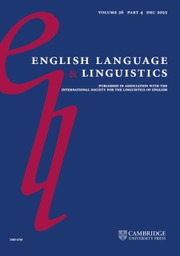Article contents
Relative complexity in scientific discourse
Published online by Cambridge University Press: 01 June 2012
Abstract
Variation and change in relativization strategies are well documented. Previous studies have looked at issues such as (a) relativizer choice with respect to the semantics of the antecedent and type of relative, (b) prescriptive traditions, (c) variation across text types and regional varieties, and (d) the role that relative clauses play in the organization of information within the noun phrase.
In this article, our focus is on scientific writing in British and American English. The addition of American scientific texts to the ARCHER corpus gives us the opportunity to compare scientific discourse in the two national varieties of English over the whole Late Modern period. Furthermore, ARCHER has been parsed, and this kind of syntactic annotation facilitates the retrieval of information that was previously difficult to obtain. We take advantage of new data and annotation to investigate two largely unrelated topics: relativizer choice and textual organization within the NP.
First, parsing facilitates easy retrieval of relative clauses which were previously difficult to retrieve from plain-text corpora by automatic means, namely that- and zero relatives. We study the diachronic change in relativizer choice in British and American scientific writing over the last three hundred years; we also test for the accuracy of the automatically retrieved data. In addition, we trace the development of the prescriptive aversion to which in restrictive relatives (largely peculiar to American English).
Second, the parsed data allow us to investigate development in the structure of the NP in this genre, including not only phrasal but also clausal modification of the head noun. We examine the contribution of relative clauses to NP complexity, sentence length and structure. Structural changes within the NP, we argue, are related to the increased professionalization of the scientific publication process.
Information
- Type
- Research Article
- Information
- English Language & Linguistics , Volume 16 , Issue 2: Selected papers from the Fourth International Conference on Late Modern English , July 2012 , pp. 209 - 240
- Copyright
- Copyright © Cambridge University Press 2012
References
- 20
- Cited by

